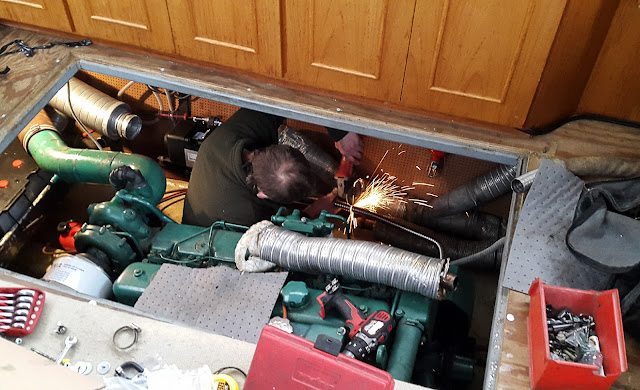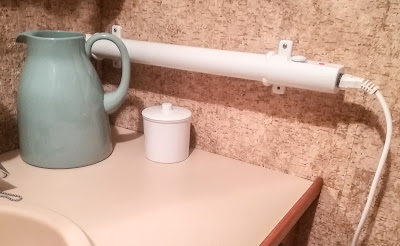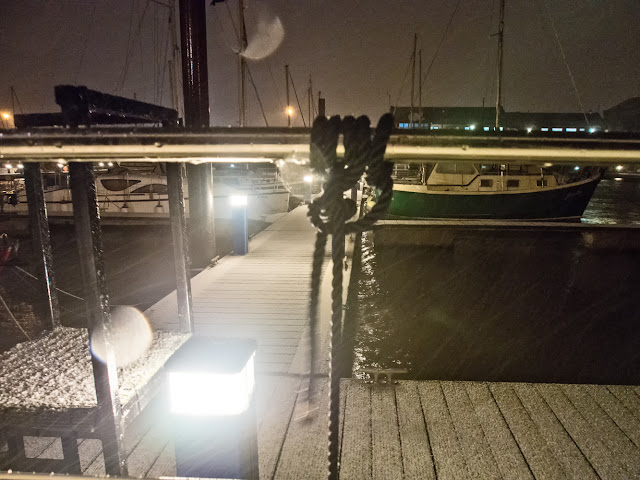 |
Ravensdale's welcoming glow on a cold, dark night |
Why do folk who live on the land think liveaboards must freeze in the winter?
The first thing many people seem to assume if we tell them we live on our boat is that we must get really cold when the temperatures start to drop outside.
Why?
I just don’t get it!
If someone tells you they live in a house, you don’t automatically launch into a series of questions about what type of heating they have.
But, if you live on a boat, it seems to be the first thing people want to know.
The questions sometimes vary, but the sentiment is the same.
“Don’t you get cold in the winter?”
“How do you keep warm?”
“Do you have heating?”
Yes, of course we have heating.
We wouldn’t have moved on board our Neptunus 133 Ravensdale at Maryport in Cumbria, UK, if we didn’t have the ability to keep ourselves warm.
The next question is likely to be about the type of heating, which is fair enough.
Actually, it’s all fair enough really. Our lifestyle is outside most people’s experience and they’re just interested to learn more.
And, to be honest, we're happy to explain how we manage to keep warm on board to anyone who genuinely wants to know more about it.
 |
Ravensdale's super efficient Webasto heater |
Ravensdale has a very efficient and very effective Webasto hot air diesel heating system.
 |
Phil with the old heater |
That said, this time last year, we were in a very different situation.
The Eberspacher heating system that was onboard when we bought our 43ft seagoing cruiser packed up on January 5 - http://fromahousetoaboat.blogspot.co.uk/2017/01/our-heater-is-dead-and-marina-has.html
And it took a month for the company we took it to for repairs to discover it was beyond repair and to get us a replacement. It had to be ordered from Germany and the first one sent went missing in transit.
We were very lucky that it was a particularly mild period for January/February, but it was still pretty chilly.
We got by with a couple of small electric heaters, which pushed our weekly electricity costs up from around £20 per week to £50 per week, but it made life just about bearable until the new heater was fitted - http://fromahousetoaboat.blogspot.co.uk/2017/02/at-long-last-we-have-heat.html
Ravensdale’s heating system
The new system we had fitted was the Webasto Airtop Evo 55 diesel 24V, which is designed for use in trucks, vans and mobile homes.
 |
The new Webasto heater being fitted in February 2017 |
 |
One of the heating outlets in the saloon |
It’s capable of providing heat at five outlets, but we currently only have four – two in the saloon, one in the dinette/galley area and one in the aft cabin (AKA our bedroom).
 |
Space heater in the bathroom |
We’re considering piping the hot air through to the fore cabin and installing a fifth outlet there as there’s currently no proper heating at that end of the boat.
But it’s not really a problem as the cabin is only used for storage at the moment and we have a dehumidifier running in there as and when needed.
There’s also no heat in the heads in the fore cabin so we’re planning to install a space heater in there very soon.
Another improvement we plan to make as soon as possible is to fit a thermostat and timer to the Webasto system as we currently have to control it using knobs to turn the heat up or down.
 |
The controls for our Webasto heating system |
We tend to keep it on a low economy setting overnight, turning it up a bit just before we get up.
We then keep it on economy for most of the day, unless it’s very cold, and we switch it up to the lower of the two main heat settings during the evening, adjusting the temperature on that setting as required. We haven’t needed to use the highest settings yet.
The temperature on board ranges between about 13C and 16C (55.4F - 60.8F) during the night, around 20C (68F) during the day and about 24C (75.2F) during the evening.
Other means of keeping warm
1. Dehumidifiers – We have two, one in the fore cabin and one in the aft cabin. These give out some heat, but mainly ensure that the boat remains dry. The one in the aft cabin is on for about an hour before going to bed and an hour after we get up in the morning. The one in the fore cabin is on all night with the doors to the rest of the boat left open to keep the whole boat dry. We also bring one of them up into the saloon at any time that condensation starts to form.
2. Electric blanket – Absolutely invaluable during the winter months and pretty good to have during much of the spring and autumn too.
 |
Warm brushed cotton bedding with a dehumidifier in the corner |
3. Brushed cotton bedding – A recent addition, but one we would thoroughly recommend. The warmer feel of the fabric makes for a much cosier night’s sleep.
4. Thermal underwear – A sleeveless vest is a big help during cooler periods and, when it gets really cold, we don our thermal base layer underwear that was initially bought for mountain walking.
 |
Me in a warm, woolly hat |
5. Always wrap up and wear a warm hat when going out – It’s much easier to stay warm than to have to warm up again after getting cold.
6. And finally, my personal tip for keeping warm – Always make your husband get up and turn the heating up a good half an hour before you get out of bed. Trust me! It works! J
The dreaded lurgy
The flu-type bug I developed almost a fortnight ago is still making its presence known and I’ve been particularly grateful for our excellent onboard heating system while feeling unwell.
Phil never caught the full-blown flu, but has been feeling less than 100% much of the time so we’re convinced his body has been fighting off the bug too.
Hopefully we will both be back on top form very soon.
Wet and windy weather
 |
Phil checking the wind speed with a hand-held anemometer |
The past week has been a mixture of wind, rain and even a little bit of snow.
We had a thin covering of snow on our aft deck and the pontoons for a short while at around 6.30pm on Tuesday evening after blizzard conditions, which must have lasted all of about 10 minutes.
 |
Snow on Ravensdale's aft deck |
 |
Snow being blown around by high winds as it starts to settle on the pontoons |
But most of the time the weather has either been very windy or raining or both – just typical UK winter weather really J
We had very stormy conditions overnight Sunday into Monday, with 33mph southerly winds, gusting to 46mph, recorded at nearby St Bees Head at midnight.
This continued throughout the day on Monday, overnight Monday into Tuesday and during the day on Tuesday.
 |
Storm clouds gathering over Maryport Marina |
The highest wind speed recorded in this area on Monday/Tuesday night was a westerly 36mph wind, gusting to 48mph at 4am on Tuesday.
Ravensdale’s TV aerial blew off again and Phil had to get dressed and go out in the wind and rain at around 2am to lash it down.
He fixed it again the following morning and we now know that we need to make some alterations to stop this happening every time we get high winds. Amazingly, the programmes that were scheduled to record that night were still recorded with very little disturbance to the reception.
 |
Phil fixing the TV aerial after it came loose in the latest storms |
Overnight Tuesday into Wednesday was another stormy night as Storm Fionn battered the UK leaving large swathes of the country covered by deep snow.
Maryport was on the edge of the various severe weather warnings for snow, ice and strong winds that the Met Office issued for Storm Fionn and it seems they were right as we certainly seem to have missed the worst of it this time.
Boat jobs
 |
One of Ravensdale's crushed fenders |
We haven’t really got back into doing any of the long list of jobs that want/need doing on Ravensdale since our Christmas and New Year shutdown.
Bad weather and feeling unwell have meant we’ve just been relaxing on board, waiting for the flu bug to run its course and for the weather to improve.
However, Phil changed the valves on a couple of fenders that suffered while being repeatedly squashed between Ravensdale’s hull and the pontoon during Storm Eleanor on January 2 and 3.
There was a bit of a delay as we’d run out of valves so we had to order more and wait for them to arrive.
But the fenders were blown up and back in place ready to take the strain before the worst of the high winds this week.
Meanwhile, the swans that can often be seen around the marina have been visiting our boat looking for food because the person who usually feeds them is away at the moment. We didn't have any proper swan food to offer them, but they seemed to quite like slices of potato.
Meanwhile, the swans that can often be seen around the marina have been visiting our boat looking for food because the person who usually feeds them is away at the moment. We didn't have any proper swan food to offer them, but they seemed to quite like slices of potato.
 |
The swans swimming towards Ravensdale in search of food |
 |
Phil feeding potato to one of the swans |